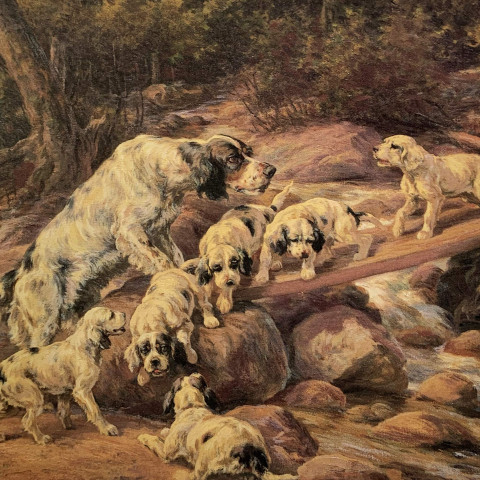Born in Hildesheim, Germany, Edmund Osthaus studied at the Royal Academy of Arts between 1874 and 1882. There in Düsseldorf he was instructed by noted artists Andreas Müller, Peter Jansen, E.V. Gebhardt, E. Deger and later by Christian Kroner a wildlife painter and landscapist.
Osthaus immigrated to the United States in 1883 to be with his parents in Ohio. He eventually became the chief instructor of the Toledo Academy of Fine Arts, and later the director of the Academy between 1886 and 1893. After he resigned, Osthaus devoted his time to shooting and painting for his own fulfillment.
Osthaus knew dogs comprehensively and participated in field trials and confirmation shows with his own setters and pointers. Furthermore, he judged trials and was a charter member of the National Field Trial Association formed in Newton, North Carolina in 1895. His immersion in the world of competitive gun dogs provided abundant subject matter.
True to his classical art education, Osthaus executed detailed and life-like portraits of dogs in the field at work, and at play and rest. His mediums were watercolor, oil and pencil. Many of his paintings included field trial champion pointers and setters. Generally he executed compositions of one, two or three dogs and on occasion more, working from life. His paintings are captivating and pull viewers into the composition - one can easily imagine his dogs running afield and moments of suspense from the hunt.
Osthaus painted setters which display a traditional sitting position. Setters were derived from medieval hunting dogs that were trained to find birds and then to "set" (crouch or lie down) so that a net could be thrown over both the birds and dog. As firearms came into use, setters were trained to adopt a more upright stance. Over time, training elevated the tail of setters and pointers to an upright position.
The artist's paintings came into great demand in the late 1890's. Wealthy families and collectors, such as the Vanderbilts and Morgans, became patrons commissioning large scenes for their lavish homes. Also, Osthaus furthered his reputation with a series of postcards, prints, and calendar pictures done for the DuPont Company.
Osthaus established a studio in Los Angeles, California in 1911 and stayed there for the remainder of his life. However, he traveled frequently, painting throughout the States. He maintained homes in Ohio and New Jersey, and wintered on his hunting property in Marianna, Florida. On January 30, 1928, at the age of seventy, Osthaus passed away while at his Florida lodge. Today he is best known for having chronicled the American field dog and producing a sizable body of scenes of gun dogs at work of exceptional quality.
Written by Curtis Tierney
Sources:
William Secord, A Breed Apart, The Art Collection of the American Kennel Club and the American Kennel Club Museum of the Dog
The Horse and Hound in Art: An Encyclopedia of Sporting Art
Literature:
A Breed Apart, The Art Collection of the American Kennel Club and the American Kennel Club Museum of the Dog, Secord, William, Antique Collector's Club, Woodbridge, Suffolk England, 2001, 325 pages
Animal and Sporting Art in America, Reuter Jr., Turner, The National Sporting Library, Middleburg, Virginia, 2008, 880 pages
Artists in California, 1786-1940, Hughes, Edan Milton, Crocker Art Museum, Sacramento, California, 2002, 1250 pages (two volumes)
Collections:
Butler Institute of American Art, Youngstown, Ohio
Oshkosh Public Museum, Oshkosh, Wisconsin
Port Huron Museum, Port Huron, Michigan
The Toledo Museum of Art, Toledo, Ohio
The Washington County Museum of Fine Arts, Hagerstown, Maryland

